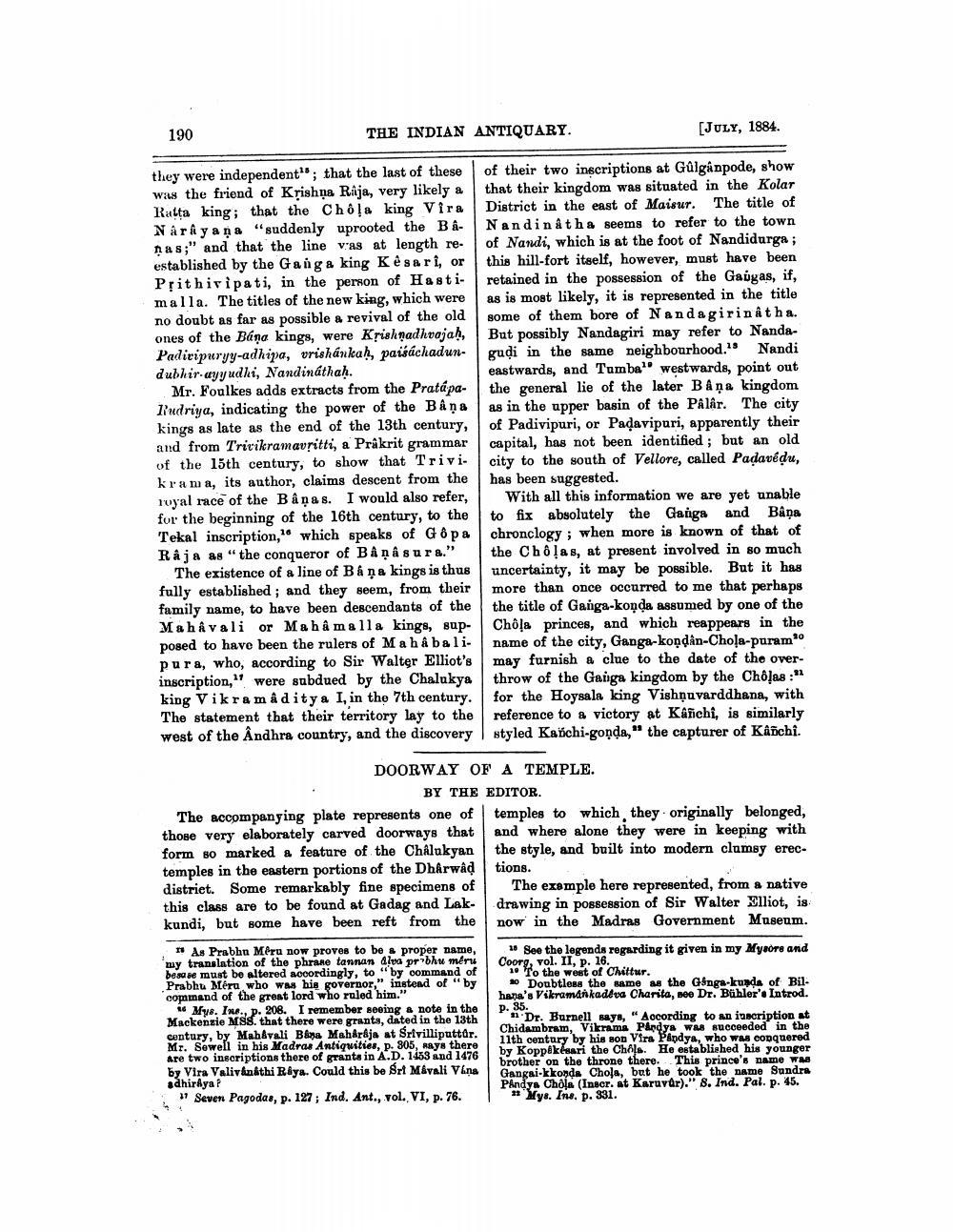________________
190
THE INDIAN ANTIQUARY.
[JULY, 1884.
they were independent"; that the last of these of their two inscriptions at Gulgánpode, show was the friend of Krishna Raja, very likely a that their kingdom was situated in the Kolar Ratta king; that the Chola king Vira District in the east of Maisur. The title of Narayana "suddenly uprooted the BA- Nandinátha seems to refer to the town nas;" and that the line vias at length re- of Nandi, which is at the foot of Nandidurga ; established by the Ganga king Kesari, or this hill-fort itself, however, must have been Prithiripati, in the person of Hasti- retained in the possession of the Gauyas, if, malla. The titles of the new king, which were as is most likely, it is represented in the title no doubt as far as possible a revival of the old some of them bore of Nandagirinatha. ones of the Báno kings, were Krishnadhvajah, But possibly Nandagiri may refer to NandaPadiripuryy-adhipa, vrishánkah, paisáchadun- gudi in the same neighbourhood." Nandi dubhir ayyudki, Nandináthah.
eastwards, and Tumba" westwards, point out Mr. Foulkes adds extracts from the Pratápa- the general lie of the later B &ņa kingdom Rudriya, indicating the power of the Båņa as in the upper basin of the Palar. The city kings as late as the end of the 13th century, of Padivipuri, or Padavipuri, apparently their and from Trivikramavritti, a Prakrit grammar capital, has not been identified; but an old of the 15th century, to show that Trivi. city to the south of Vellore, called Padavedu, krama, its author, claims descent from the has been suggested. royal race of the Bâņas. I would also refer, With all this information we are yet unable for the beginning of the 16th century, to the to fix absolutely the Ganga and Bana Tekal inscription, which speaks of Gôpa chronclogy; when more is known of that of Raja as "the conqueror of BAÑâ su ra." I the Chôļas, at present involved in so much
The existence of a line of Bina kings is thus uncertainty, it may be possible. But it has fully established ; and they seem, from their more than once occurred to me that perhaps family name, to have been descendants of the the title of Ganga-konda assumed by one of the Mahivali or Mahâ malla kings, sup- Chļa princes, and which reappears in the posed to have been the rulers of Mahabali- name of the city, Ganga-koņdân-Choļa-puram" pura, who, according to Sir Walter Elliot's may furnish a clue to the date of the overinscription," were subdued by the Chalukya throw of the Ganga kingdom by the Chôļas :" king Vikramaditya I, in the 7th century. for the Hoysala king Vishnuvarddhana, with The statement that their territory lay to the reference to a victory at Kafichi, is similarly west of the Andhra country, and the discovery styled Karchi-gonda," the capturer of Kâğchi.
DOORWAY OF A TEMPLE.
BY THE EDITOR. The accompanying plate represents one of temples to which they originally belonged, those very elaborately carved doorways that and where alone they were in keeping with form 80 marked a feature of the Chalukyan the style, and built into modern clumsy erectemples in the eastern portions of the Dharwad tions. distriet. Some remarkably fine specimens of The example here represented, from a native this class are to be found at Gadag and Lak. drawing in possession of Sir Walter Elliot, is kundi, but some have been reft from the now in the Madras Government Museum.
As Prabhu Moru now proves to be proper name, my translation of the phrase tannan alpa pribhu mér besore must be altered accordingly, to "by command of Prabhu Méru who was his governor," instead of "by command of the great lord who ruled him."
16 Mye. Ine., p. 208. I remember seeing a note in the Mackenzie MSS. that there were grants, dated in the 13th century, by Mahevali Bana Maharaja at Srivilliputtar. Mr. Sewell in his Madras Antiquities, p. 805, says there are two inscriptions there of grants in A.D. 1453 and 1476 by Vira Valivanathi Riya. Could this be Srt Mávali Vlna adhiraya ?
"Seven Pagodas, p. 127; Ind. Ant., vol. VI, p. 76.
See the legends regarding it given in my Mysore and Coor, vol. II, p. 16.
1. To the west of Chittur.
* Doubtless the same as the Gónga-kunda of Bilhana's Vikramankadéra Charita, nee Dr. Bühler's Introd. p. 85.
1. Dr. Burnell says, " According to an inscription at Chidambram, Vikrama Pandya Wo succeeded in the 11th century by his son Vira Pandya, who was conquered by Koppékésari the Chols. He established his younger brother on the throne there. This prince's name wa Gangai-kkonda Chola, but he took the name Sundra Pandya Chola (Inscr. at Karuvar)." 8. Ind. Pal. p. 45.
ye. Ine. p. 331.




